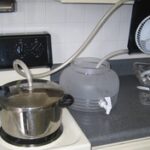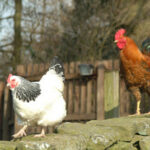I began solar cooking in 2006 when I lived in Manhattan. I had an apartment with an excellent southern exposure on the balcony so I bought a panel cooker on eBay. It was a very simple design, made mostly of plastic and it required the use of oven bags in order to create the greenhouse effect necessary for cooking food. It had severe limitations but I managed to cook a few chickens and meatloaves with it. Through research, I discovered that a serious, more powerful solar oven cost about $250 and so this year, for my birthday, I decided to make the investment myself. After careful searching, I bought a box cooker from Sun Oven International, a small company based in Elburn, Illinois. I purchased a kit that came not only with the oven but also two black enamel pans, stacking trays and a water pasteurization indicator.
The delivery came by postal service in one big box. It took less than 15 minutes to remove all of the packaging and inventory the contents. The Sun Oven is a well built, American-made piece of equipment. The interior is composed of black metal with a platform on hinges that rotates as you adjust the level of the oven. The exterior of box is hard, black PVC, while in between is insulation to insure that as little heat as possible escapes. The front of the oven is a piece of thick safety glass on hinges. There is also an array of thin metal reflectors. The oven is very easy to set up; you simply place your oven in the sun, open the reflectors, put the food inside on the platform and then close the glass door.
The principle of a solar cooker can be understood as an exaggerated greenhouse effect, similar to what you experience when you step into a hot car in the summer sun. Light passes through the glass of the oven. When it strikes the black of the interior or the cookware, it is converted to heat, which cannot escape back through the glass. The insulation of the oven prevents heat loss and the reflectors quadruple the amount of the light. There’s a built in thermometer so that you can see for yourself just how hot the Sun Oven can get. Sun Oven’s advertising claims the oven can reach temperatures between 350 and 400° F. In six weeks of cooking, I’ve attained a maximum temperature of 370°. There are, of course, practical limits to solar cooking. Clouds lengthen cooking time, while on a completely overcast day you can’t do it at all. The best sunshine is that of midday, between 10:00 AM and 2 PM. The ambient temperature actually has no effect at all, however, as the Sun Oven is well insulated at it’s the sunlight, itself, that heats the oven.
The Sun Oven comes with a CD with a video explaining its operation and a PDF cookbook of various recipes. I’ve made some of the recipes myself, including BBQ ribs and banana bread. Most cooking I’ve done, though, is according to my own recipes. The main differences are that you need less water or oil as no moisture can escape during cooking and that you don’t need to stir anything as the heat inside the Sun Oven is uniform and so the pot can’t burn the food and nothing ever sticks. In fact, you don’t want to open the door while cooking as the built up heat escapes.
After cooking with the Sun Oven 15-20 times I’ve found that it’s an extremely well built machine that is easy to master. The limitations of the Sun Oven are those inherent in solar cooking; sometimes the weather simply won’t cooperate with your plans and so you have to put your meal in the conventional oven to finish. In direct sunlight a corn bread or banana bread cooks in under an hour. Meatloaf and chicken cooks through in a few hours without losing moisture. Pot roasts and ribs are fall-off-the-bone tender. It takes patience to solar cook but it’s interesting, rewarding and environmentally responsible to use the Sun Oven as an occasional substitute for your traditional stove.







